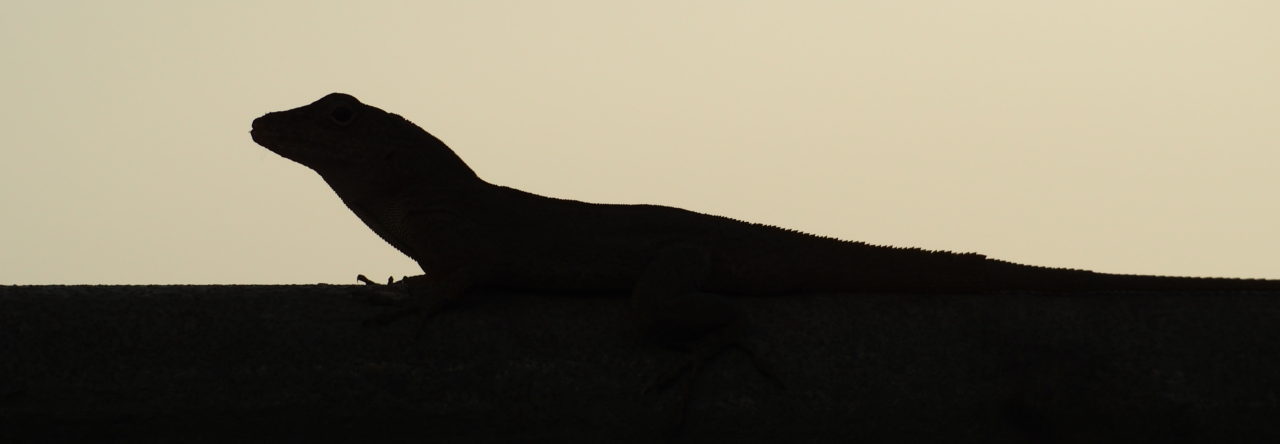The Travel section of the NYT recently featured Caribbean getaways and, of course, anoles were a criteria for choosing which destinations to feature. This isn’t a tough one, but can anyone identify this agave-loving anole?
Author: Jonathan Losos Page 111 of 131
Professor of Biology and Director of the Living Earth Collaborative at Washington University in Saint Louis. I've spent my entire professional career studying anoles and have discovered that the more I learn about anoles, the more I realize I don't know.
In response to recent discussion of dead-playing anoles, AA‘s French connection Ludovic recently brought to our attention a video of an A. coelestinus doing the same, while floating in a sink.
And as an extra treat, Youtube then directed the alert viewer to a bonus track of what appears to be a fuzzy A. stratulus going to town on a slice of watermelon.
The fossil record of anoles is disappointingly small. Other than very young (a few thousand years old) fossils found in caves, where owls and other predators may have left them, only four full-fledged fossils are known from the scientific literature. All are lizards preserved in amber, approximately 20 million years old (give or take a few million). Here’s a picture of one here.
But there are a lot more in private hands. The problem, however, is Jurassic Park. Remember how the mad scientists got their dinosaur DNA? They extracted it from mosquitoes entombed in amber. And where did the amber come from? Perhaps you recall the scene of the lawyer (later justifiably devoured by T. rex) getting off a river raft to purchase some amber. Where? The Dominican Republic. And it turns out that those amber mines do exist, only their deposits date to the Miocene, not the Cretaceous. And, more importantly, as well as skeeters and other invertebrates, occasionally an anole-laden piece of amber emerges from these mines.
For an interesting discussion of how the anole genome informs about human genetics, and discussion of a creationist’s claim that the anole genome can’t tell us anything about evolution, check out the latest post in Anolis Tollis.
I just read another paper that uses the term “ecomorph,” this one in reference to populations of insects. We anolologists know that Ernest Williams introduced the term “ecomorph” in his classic 1972 paper (available here), defining an ecomorph as those “species with the same structural habitat/niche, similar in morphology and behavior, but not necessarily close phyletically.” The terms “ecomorph” and “ecomorphology” are now widely used. Was Williams really the one who coined the term? And is its current use consistent with the ideas he developed?
On the Tropical Herping website, Lucas Bustamante provides a report–accompanied by gorgeous photographs–of the seven species of anoles, as well as other reptiles and amphibians, found on a Tropical Herping field trip to Chical, a frontier site near the border of Ecuador and Colombia where the faunas of the Chocoan lowlands and the Andes meet. The diversity of species found on the trip was spectacular, but Bustamante aptly noted that the “anoles were the highlight.”
Photo of a dew-covered A. carolinensis by Jude Haase at http://500px.com/photo/2565902?from=popular

Grackle snacking on an anole in Florida. Photo by Andy Wilson from http://www.pbase.com/andywilson/image/60039533
Most anole watchers have experienced the phenomenon of walking up to an anole and having it display. What good could come of displaying to a potential predator thousands of times more massive? In a perceptive experiment, Leal suggested that anoles actually are trying to tell the predators something: specifically, that a displaying lizard is very fit, and that a potential predator, in this case a snake, would be better served looking elsewhere for a meal.
But there are few observations of anoles displaying to predators in nature. In a recent Natural History Note in Herpetological Review (42:427-428), Catherine Levey documents one such instance: “I observed an adult female boat-tailed grackle (Quiscalus major) on a sidewalk with an A. sagrei in its bill. The anole was approximately 7 cm snout-vent length. The bird was vigorously shaking the anole with sideways flicks of its head. After about five seconds, it put the anole down on the pavement. The anole immediately arched its back, fully extended its dewlap, and became immobile. The bird looked at it and did not move for about five seconds. It then pecked the anole several times near the head, which caused the anole to withdraw its dewlap and run. The bird pursued it and picked it up. The anole thrashed in the bird’s bill; it did not extend its dewlap. Again, the bird put it down and again it immediately displayed its dewlap. the bird paused for a few seconds, picked up the lizard by its midsection, and flew out of sight.”








